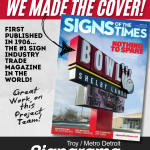There are different types of signs that a place of business needs, and chief among these are the designation signs and the means of egress signs. They in the interior of every office building and are a big part of your business’ first impression on visitors and making sure the layout of your workplace is clear.
Designation signs are dedicated to identifying permanent rooms and spaces, like conference rooms and reception desks, while means of egress signs direct people to the exits of a building. They both have the same requirements: they have to be inclusive of tactile lettering and braille. To make sure you fulfil the specific requirements, make sure to go with a professional team for ADA sign & engraving in Troy, MI.
They are made in compliance with the Americans with Disabilities Act or ADA, earning them the industry nickname “ADA signage,” and they’re more than what first meets the eye. The tactile lettering portion of the sign, aside from informing people who can read from afar, is also designed for people who may have lost their sight at a later age and might have a hard time reading braille.
Here are a few general guidelines for the alphanumeric portion of the sign:
- People should be able to differentiate between the sign’s surface, lettering, and braille section by touch.
- For lettering to be considered tactile, it needs to be offset from the sign at the minimum of 1/32 of an inch.
- Tactile lettering must be all uppercase and in sans serif, meaning they should have no extruding lines or accents at the edge of its letters similar to fonts like Times New Roman.
- Tactile lettering should not be italic, oblique, or have any highly decorative features.
- The horizontal and vertical spaces between letters are strictly regulated, as well as the proportion of the fonts and their stroke thickness.
For the braille portion of an ADA sign, there is another prevailing set of guidelines. These are enforced to accommodate people with severe visual impairments, including those who totally can’t see:
- The braille should be Grade 2, a system with around 250 letters, numerals, and formatting marks which is considered the space-saving alternative to Grade 1 braille.
- It should be domed or rounded in shape.
- It should be located below all lines of tactile text, especially in multi-lined signs.
- At least 3/8 inches of space is needed between the tactile text and the braille, and between all decorative elements in the sign.
Making an ADA sign for your business will entail strict observance of meticulous laws in addition to your state’s building codes. They have to be made from lightweight material that is easily mounted and transferrable to other parts of your building. This makes plastic the ideal choice for an ADA sign.
Apart from the glare that metallic material is susceptible to from many indoor light sources, plastic is also easier to modify in compliance with proper contrast percentages.
Troy, Michigan, along with the whole state in general, is very accommodating of ADA laws, providing aids and services to people with disabilities so they can participate in state-sponsored activities. For private businesses, they should seek out the best ADA sign & engraving service in Troy, MI, to fully comply with government regulations.




